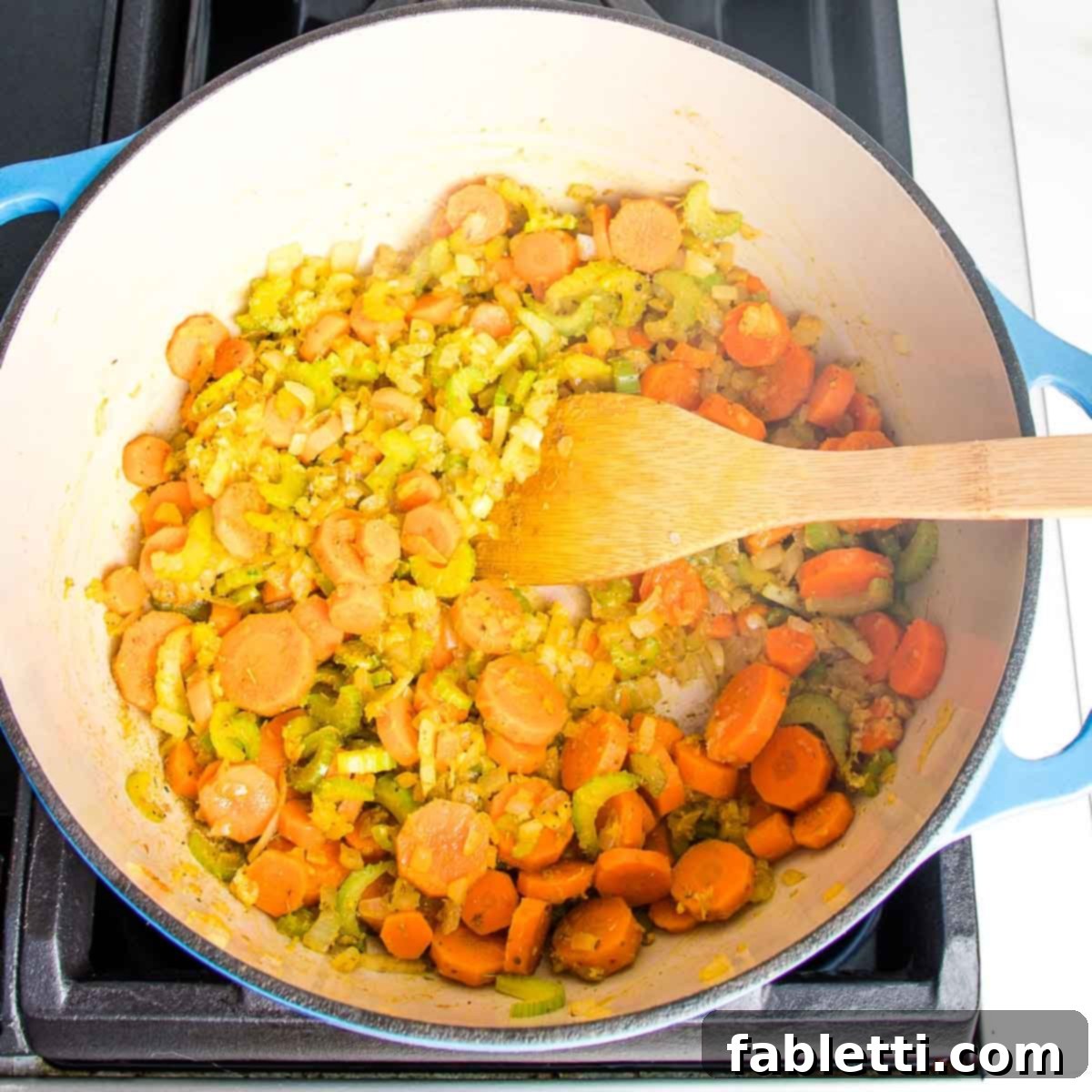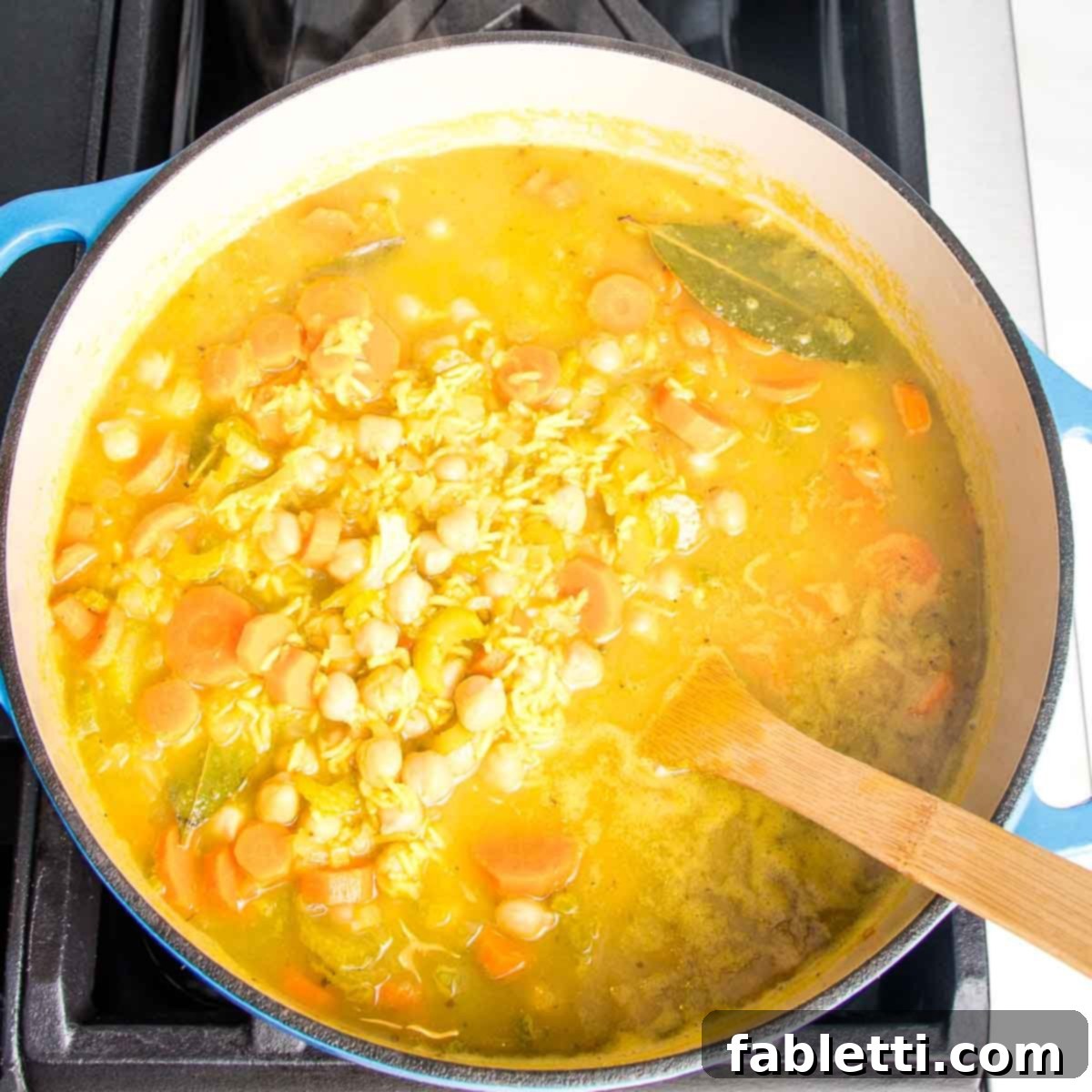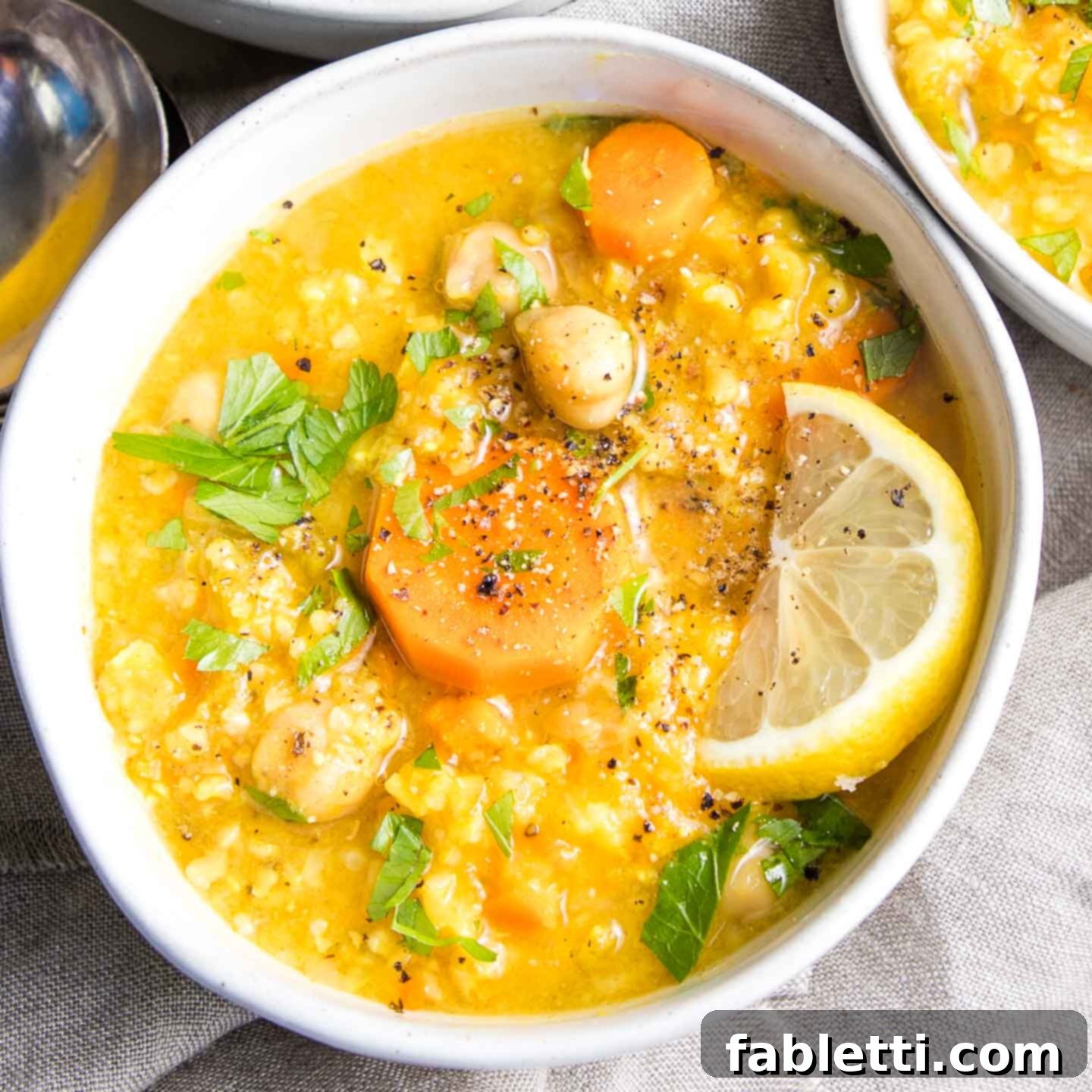There’s nothing quite like a warm, comforting bowl of soup to soothe the soul, especially when it’s bursting with vibrant flavors and wholesome ingredients. This Chickpea Soup with Lemon and Rice is that perfect remedy, offering a nourishing embrace in every spoonful. It’s an incredibly easy one-pot meal that delivers a satisfying experience, feeling like a warm hug on a chilly day. Whether you’re seeking a hearty weeknight dinner or a delightful lunch, this vegan recipe promises both deliciousness and ease.

(This post has been updated from its original publication on September 23, 2020, to provide enhanced details and tips for an even better soup experience.)
This lemon rice soup stands out as the ultimate fall and winter comfort food. It masterfully balances a hearty, filling profile with a refreshing lightness, making it suitable for any season. At its core, you’ll find warming spices, a beautiful golden color, and a delightful chewy, nutty texture from the rice and chickpeas. What makes this recipe truly special is its simplicity: a single pot means minimal cleanup, and very little hands-on time means you can easily whip up this lemony chickpea soup on even the busiest weeknights. Transform simple pantry staples and a few fresh ingredients into a super tasty, nutritious, and incredibly cozy meal that will satisfy everyone at your table.
Why You’ll Absolutely Adore This Vegan Chickpea Lemon Rice Soup

- Incredibly Satisfying: This soup boasts an amazing texture and rich, layered flavors. It’s wonderfully filling and hearty, yet never feels heavy. The combination of chickpeas and rice provides a complete plant-based protein, keeping you satiated for longer.
- Effortless One-Pot Meal & Easy Cleanup: Say goodbye to piles of dishes! This entire recipe comes together in a single pot. For a truly minimal cleanup experience, a little secret: I often store any leftover soup directly in the cooking pot in the fridge. That’s a win-win for delicious food and less work!
- Nutrient-Packed Goodness: Don’t let the comfort fool you – this soup is a powerhouse of nutrition. It’s rich in plant-based protein, dietary fiber, powerful antioxidants, and anti-inflammatory ingredients like turmeric and fresh lemon. It’s a meal that truly nourishes your body from the inside out.
- Perfect for Healthy Meal Prep: This soup is an excellent candidate for meal prepping. Make a large batch, and you’ll have wholesome, ready-to-eat meals for the entire week. Plus, it freezes beautifully, making it ideal for future quick meals. Just thaw, reheat, and enjoy!
- Incredibly Versatile: This delightful soup is perfect for any meal of the day. Enjoy it for a cozy lunch, a satisfying dinner, or even as a unique and refreshing way to break your fast in the morning. Yes, I often enjoy a warm bowl for breakfast – it’s that good and good for you!
Key Ingredients & Smart Substitutions for Your Perfect Soup

- Chickpeas: These humble legumes are the star of our soup, providing a robust plant-based protein and essential fiber, making this vegan soup incredibly hearty and satisfying. They contribute to the soup’s creamy texture when partially blended and a delightful bite when left whole.
- Substitution: Great northern beans, cannellini beans, or even lentils can be used as alternatives.
- Basmati Rice: Whether you choose brown or white basmati rice, it adds a wonderful texture and body to the soup. The long, slender grains cook beautifully and absorb the rich flavors. When combined with chickpeas, rice forms a complete plant-based protein, providing all essential amino acids.
- Substitution: Jasmine rice is an excellent substitute for basmati. For a chewier texture or if you’re avoiding grains, wild rice (which is technically a grass) works wonderfully, though it may require a slightly longer cooking time.
- Mirepoix (Onions, Carrots, Celery): This classic aromatic base is often referred to as the “holy trinity” of soup beginnings. Sautéing these vegetables creates a foundational layer of savory flavor that elevates the entire dish. My daughter affectionately called them “soup beginnings” when she was little, and it truly is how most delicious soups get their start!
- Lemons: Fresh lemons are absolutely crucial for this soup, providing its signature bright and zesty flavor. Both the zest and the juice are used to infuse the soup with a refreshing tang that cuts through the richness and invigorates the palate. Don’t skip the fresh lemon – it’s a game-changer!
- Miso Paste: A true secret weapon for plant-based cooking, miso paste is a powerful flavor enhancer that adds a deep umami richness to vegan soups. It’s my go-to ingredient anytime a soup recipe traditionally calls for ham or bones, as it delivers a similar savory depth without any animal products. I typically use a mellow light miso, but white miso also works well.
- Substitution: For those with soy allergies or looking to reduce soy intake, chickpea miso is a fantastic alternative that provides the same incredible flavor boost.
- Spices (Dried Oregano, Ground Cumin, Ground Coriander, Ground Turmeric, Sea Salt, Black Pepper): This carefully selected blend of spices adds warmth, complexity, and a beautiful golden hue to the soup. Turmeric, in particular, contributes anti-inflammatory benefits and a vibrant color. Adjust the salt and pepper to your personal taste.
- Vegetable Broth: The liquid base of our soup, good quality vegetable broth is essential for building flavor. Homemade vegetable stock will offer the richest taste, but a good store-bought broth works perfectly well.
- Bay Leaves: These fragrant leaves infuse the soup with a subtle, aromatic depth during cooking. Remember to remove them before serving.
- Fresh Parsley: Used as a garnish, fresh parsley adds a burst of freshness and a touch of color, enhancing both the flavor and visual appeal of the finished soup.
Choosing the Right Rice for Your Lemon Chickpea Soup
While I often opt for brown basmati rice for its nutty flavor and added fiber, this soup is incredibly adaptable to different rice varieties. I’ve also had fantastic results using white jasmine rice, which offers a softer texture and quicker cooking time. Wild rice is another excellent choice if you enjoy a more substantial, chewy texture; it also has the benefit of being technically a grass, making it a good option if you’re navigating certain dietary preferences. Keep in mind that wild rice will generally require an additional 10-15 minutes of cooking compared to white rice. Ultimately, the best kind of rice to use is truly what you have readily available in your pantry. Don’t feel limited – feel free to experiment with your favorite!
How to Craft This Delicious One-Pot Chickpea Lemon Rice Soup
Creating this nourishing lemon chickpea rice soup is a straightforward and rewarding process. Follow these simple steps to bring a bowl of plant-based comfort to your table:
Step 1: Sauté the Aromatics (Mirepoix)
Begin by heating a Dutch oven or a large, heavy-bottomed soup pot over medium heat. Perform a quick water sauté with the chopped onions, carrots, and celery. I’ve tested this step with both olive oil and water, and found no discernible difference in the final taste, making water sauté a great oil-free option. Cook, stirring occasionally, for about 5 minutes until the vegetables begin to soften and develop a light golden hue. Add a tablespoon or two of water or vegetable broth as needed to prevent sticking.


Step 2: Infuse with Spices and Garlic
Next, it’s time to build the aromatic profile of your soup. Add the minced garlic and all the spices – oregano, cumin, coriander, and turmeric – directly to the pot. I love using a microplane zester right over the pot for fresh garlic, ensuring maximum flavor. You’ll immediately notice the incredible fragrance of this combination filling your kitchen – truly delightful! Cook, stirring constantly for about 2 minutes, allowing the spices to bloom in the residual heat and moisture. If the pan becomes too dry, add another tablespoon of water or broth.
Step 3: Toast the Rice
Stir the rinsed rice into the pot, ensuring each grain is thoroughly coated with the fragrant spice mixture. This brief toasting step helps to develop a deeper flavor in the rice and can prevent it from becoming overly sticky. Continue to add 1-2 tablespoons of water or vegetable broth as needed to prevent the rice from sticking to the bottom of the pan as it toasts.


Step 4: Simmer with Broth and Chickpeas
Pour in the vegetable broth and add the bay leaves to the pot. Bring the mixture to a gentle simmer, then cook uncovered for approximately 20 minutes, or until the rice is partially cooked. At this point, stir in the rinsed and drained chickpeas along with the miso paste. Ensure the miso is fully dissolved; you can also dissolve it in a few tablespoons of warm soup broth in a separate small bowl before adding it to the pot to make this process easier. Continue to simmer for another 10-15 minutes, or until the rice is tender with a pleasant chew, but not mushy. If you’re using homemade vegetable stock, you might need to add additional salt, but always taste the soup at the end before adjusting the seasoning.


Step 5: Add Miso and Lemon
As the rice continues to cook, the chickpeas will absorb the wonderful flavors of the miso and spices, deepening the overall taste profile. Once the rice reaches your desired doneness, remove the bay leaves. This is the moment to add the final, crucial boost of flavor: the lemon zest and fresh lemon juice. Zest both lemons directly into the pot and then squeeze in their juice. Stir everything thoroughly to ensure the bright lemon essence is distributed throughout the soup, creating a truly delicious and harmonious flavor.
Step 6: Achieve Your Desired Texture
For a soup with a luxurious, slightly thicker consistency and varied texture, I recommend pureeing part of the soup. You can carefully transfer one or two cups of the soup to a regular blender, blend until smooth, and then return it to the pot. Alternatively, and often easier, use an immersion blender directly in the pot. Blend only a portion, leaving plenty of delightful chunks of chickpeas, rice, and vegetables – that varied texture is part of the fun! If the soup appears too thick after blending, simply add more water or vegetable broth until you reach your preferred consistency. Finally, taste for seasoning and adjust with more salt and pepper as needed.


Step 7: Garnish and Serve
Ladle your steaming hot soup into bowls. For a final flourish, garnish generously with fresh herbs. I particularly love the bright, clean taste of parsley, but cilantro, fresh basil, oregano, or thyme also make excellent additions and will complement the flavors beautifully. Enjoy your homemade, comforting bowl of chickpea lemon rice soup!

Expert Tips for the Perfect Chickpea Lemon Rice Soup

- Seasoning is Key: Always taste your soup when it’s completely finished cooking. Before adding more salt, give it an extra squeeze of fresh lemon juice. The acidity from the lemon can often brighten flavors and reduce the perceived need for additional salt. Adjust salt and pepper only after this final lemon check.
- Customize Your Consistency: If you prefer a thinner, more brothy lemon rice soup, simply add more vegetable broth to reach your desired consistency. You can also skip the partial pureeing step entirely if you prefer a soup with a purely chunky texture.
- Embrace the Texture: My personal preference is to partially puree about half of the soup using an immersion blender. This creates a wonderfully varied texture – some creamy thickness from the blended ingredients, alongside delightful chunks of chickpeas, rice, and vegetables. It makes for a truly fabulous eating experience! 😋
- Storage and Reheating: This soup stores beautifully in an airtight container in the refrigerator for up to 4-5 days. When reheating, you may find it has thickened considerably. Simply add a splash of water or vegetable broth to thin it back to your preferred consistency.
- Enhance the Lemon Flavor: For an even more pronounced lemon flavor, you can add an extra slice of lemon to each bowl when serving, or a final sprinkle of lemon zest just before eating. This really brightens the entire dish.
Creative Variations & Serving Suggestions
Exciting Variations to Try:
- Add More Veggies: Boost the nutritional content and flavor by stirring in leafy greens like fresh spinach or chopped kale during the last 5-10 minutes of cooking. Roasted sweet potatoes or butternut squash could also be added for a touch of sweetness and depth.
- Spice It Up: If you enjoy a bit of heat, add a pinch of red pepper flakes or a dash of your favorite hot sauce. For a smoky flavor, a teaspoon of smoked paprika would be a wonderful addition.
- Creamier Texture: For an extra luxurious and creamy soup, stir in a quarter to half a cup of full-fat coconut milk or a swirl of vegan cream at the very end of the cooking process.
- Different Legumes: While chickpeas are excellent, feel free to experiment with other legumes. White beans (cannellini or great northern) or even brown or green lentils can be swapped in for a different twist.
- Herb Variety: Beyond parsley, consider fresh dill for a different aromatic profile, or a mix of fresh basil and oregano.
Perfect Serving Suggestions:
- Crusty Bread: Serve your soup with a generous slice of warm, crusty bread or a baguette for dipping. It’s perfect for soaking up every last drop of the flavorful broth.
- Side Salad: A simple, fresh green salad with a light vinaigrette makes an excellent complement, adding a refreshing contrast to the warm soup.
- Crunchy Toppings: A sprinkle of homemade croutons, toasted seeds (like pumpkin or sunflower), or even some crispy fried onions can add a delightful textural element.
- Vegan Yogurt or Sour Cream: A dollop of plain, unsweetened vegan yogurt or sour cream swirled into each bowl adds a cool, creamy tang that balances the lemon beautifully.
- Fresh Avocado: Diced avocado adds healthy fats and a creamy texture.
Frequently Asked Questions About Chickpea Lemon Rice Soup
- Q: Can I make this soup ahead of time?
- A: Absolutely! This soup is fantastic for making ahead. The flavors tend to meld and deepen overnight, making it even more delicious the next day. Store it in an airtight container in the refrigerator.
- Q: Does this soup freeze well?
- A: Yes, it freezes beautifully! Allow the soup to cool completely, then transfer it to freezer-safe containers or bags. It can be frozen for up to 3 months. Thaw overnight in the refrigerator and reheat gently on the stovetop, adding a little extra broth or water if it’s too thick.
- Q: How can I make this soup gluten-free?
- A: This recipe is naturally gluten-free if you ensure your vegetable broth and miso paste are certified gluten-free. All other ingredients are naturally free of gluten.
- Q: What’s the best way to store leftovers?
- A: Store any leftover soup in an airtight container in the refrigerator for up to 4-5 days. As mentioned in the pro tips, you can even store it directly in the cooking pot for minimal cleanup.
- Q: Can I use dried chickpeas instead of canned?
- A: Yes, you can! If using dried chickpeas, you’ll need to cook them separately before adding them to the soup. Soak them overnight, then cook them until tender (about 1-2 hours) before proceeding with the recipe. This will add to your prep time but offers a slightly richer flavor.
- Q: My soup is too thick/too thin, how do I fix it?
- A: If your soup is too thick, simply stir in additional vegetable broth or water until it reaches your desired consistency. If it’s too thin, you can simmer it uncovered for a bit longer to reduce, or blend a larger portion of the soup to thicken it.
More Delightful Chickpea Recipes to Explore
- Healthy Baked Falafel Recipe
- Tuscan Kale Chopped Salad
- Chocolate Chunk Skillet Cookie (Vegan & Gluten-Free)
- Vegetable Pesto Pasta Salad without Mayo!
Did you know commenting and rating recipes is one of the best ways to support your favorite food bloggers? If you made this recipe, please consider leaving a five-star rating below and a comment sharing your experience. Also, we’d love to see your creations! Please share your photos on Instagram by tagging me @dkhealthcoach and using the hashtag #debraklein. Your support means the world!
📖 Recipe: Chickpea Soup with Lemon and Rice

Chickpea Soup with Lemon and Rice
This one-pot lemony chickpea soup will quickly become your “go-to” for a very comforting yet light meal. Complete plant-based protein plus super flavor will leave you incredibly satisfied and nourished.
Debra Klein
Rate this Recipe
Pin Recipe
Equipment
- Hand blender
- Wooden Spoon Set
- Microplane Grater
- Colander
- Extra Large Bamboo Cutting Board
- Global 8″ Chef’s Knife
- Dutch oven
Ingredients
2x
3x
- 1 large yellow onion (or two smaller onions), about 1 cup chopped
- 4 large carrots, about 2 cups sliced
- 3 celery ribs, about 1 cup sliced
- 6 cloves garlic, minced
- 1 teaspoon dried oregano
- 1 teaspoon ground cumin
- 1 teaspoon ground coriander
- ½ teaspoon ground turmeric
- ½ teaspoon coarse sea salt*
- ⅛ teaspoon freshly ground pepper
- ¾ cup basmati rice* (brown or white)
- 8 cups veggie broth
- 3 cups chickpeas (from 2 15-oz cans, rinsed and drained)
- ¼ cup light miso* (or chickpea miso)
- 3 bay leaves
- 2 lemons, zested and juiced
- ¼ cup fresh parsley*, chopped (for garnish)
Instructions
- Prepare ingredients: Roughly chop the onion(s), thinly slice the celery, and slice carrots into small circles. Peel and mince the garlic cloves, and measure out all spices. Rinse and drain the canned chickpeas. Rinse the rice under cold water until the water runs clear.
- Sauté aromatics: Heat a large soup pot or Dutch oven over medium heat. Add the chopped onion, celery, and carrot to the pot with 2 tablespoons of water or broth. Sauté, stirring occasionally, for about 5 minutes until the vegetables start to soften and are lightly browned. Add more water/broth (1 tablespoon at a time) as needed to prevent sticking.
- Add spices and garlic: Grate the garlic into the pot using a microplane grater (or use a garlic press/minced garlic), along with the dried oregano, ground cumin, ground coriander, ground turmeric, sea salt, and freshly ground pepper. Cook, stirring constantly, for 2 minutes until fragrant. If the bottom of the pot becomes too dry, add a small amount of extra water or broth.
- Toast rice & simmer: Add the rinsed rice to the pot and stir well to coat the grains with the spice mixture. Pour in the 8 cups of vegetable broth and add the bay leaves. Bring the soup to a simmer, then cook uncovered for 20 minutes.
- Incorporate chickpeas & miso: Stir in the rinsed chickpeas and the miso paste. Continue to stir until the miso has fully dissolved into the broth. Continue to simmer the soup for another 10-15 minutes, or until the rice is chewy and tender but not mushy.
- Finish with lemon: Remove the bay leaves from the pot. Zest both lemons directly into the soup and then squeeze in their fresh juice. Stir everything well to combine.
- Achieve desired consistency: For a thicker, more varied texture, puree a cup or two of the soup in a blender and return it to the pot. Alternatively, use an immersion blender directly in the pot to blend only a portion of the soup, leaving some delicious chunks. If the soup is too thick after blending, add more water or broth until your desired consistency is achieved*. Taste for final seasoning and add more salt and pepper as needed.
Notes
- SALT: If you’re using homemade broth, it might be unsalted, so you may need to increase the quantity of salt in the recipe. Always wait until the soup is finished and taste before determining if more salt is necessary.
- RICE: Feel free to use the type of rice you have or prefer. In addition to basmati, jasmine rice is a great option. White rice will generally be easier to digest and cook faster than brown rice. If using wild rice, add another 10 minutes to the cooking time and look for the grains to “pop” when done, ensuring it remains chewy, not mushy, regardless of the variety.
- MISO: I used a mellow light miso for this recipe. Chickpea miso is also an excellent choice, particularly for those with soy allergies or who are reducing their soy intake.
- GARNISH: I used ¼ cup of chopped fresh parsley for garnish. Fresh cilantro, basil, oregano, or thyme are also wonderful choices that will complement the soup’s flavors.
- SOUP CONSISTENCY: If you prefer a thinner, more broth-y soup, add more water or vegetable stock. Keep in mind that the soup will naturally thicken as it cools, so you might need to add more liquid when reheating than you initially anticipated.
Nutrition Information
Calories: 224kcal
Carbohydrates: 37g
Protein: 11g
Fat: 3g
Polyunsaturated Fat: 2g
Cholesterol: 1mg
Sodium: 472mg
Fiber: 11g
Sugar: 10g
Note: The nutrition calculations were performed using online tools and are estimations. To obtain the most accurate representation of the nutritional information for this recipe, you should calculate it with the actual ingredients and brands you use. You are ultimately responsible for ensuring that any nutritional information provided is accurate, complete, and useful for your specific dietary needs.
Did you make this recipe?
Please leave a review below, then snap a picture and tag me @dkhealthcoach or use hashtag #dkhealtcoach on Instagram so I can see it!
